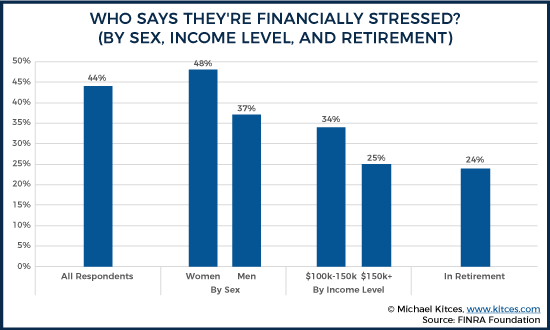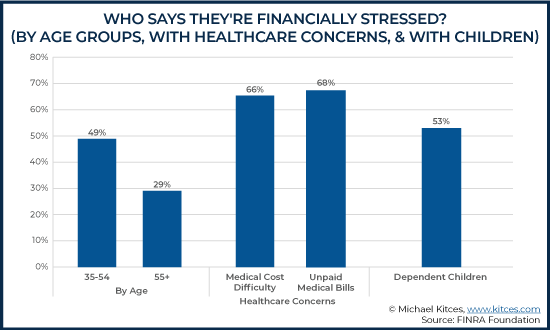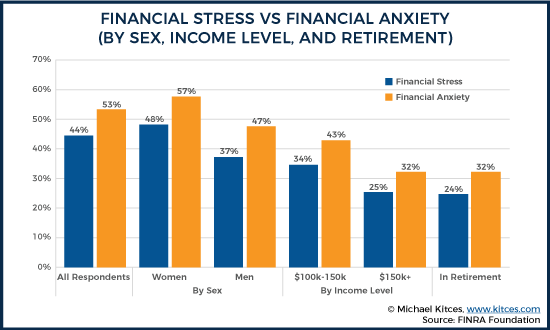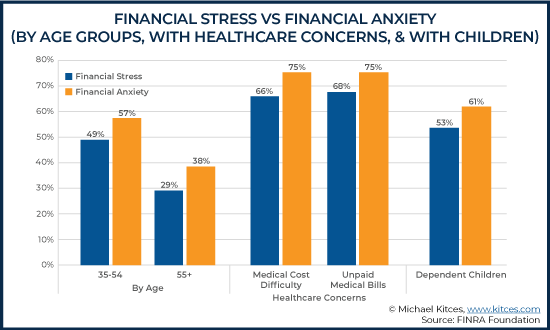Executive Summary
In today’s digital-age culture where nearly all sources of news and media are instantly accessible and information overload is a normal state of being, it is not surprising that stress and anxiety are very commonly experienced in our fast-paced society. And in fact, stress and anxiety about specific financial problems are what most often drive people to seek the help of an advisor in the first place! Which, in turn, means that advisors should have some strategies in their toolbelts to effectively help clients (prospective or otherwise) who might be stressed and anxious. Accordingly, the first step is understanding that, while the terms “stress” and “anxiety” are often used interchangeably, the reality is that they are two very different things, indeed, and require different approaches.
While stress is the result of external stimuli perceived to pose some level of threat (with a corresponding response to the threat that may involve uncertainty about one’s own ability to deal with the issue at hand), anxiety results from internal forces arising from unhealthy attitudes towards a particular idea or concept. Thus, while stress can be eliminated when the external stimuli are removed, the same is not necessarily true for anxiety. While an external stimulus might serve to trigger anxiety, removing it may have no effect on the anxiety since it is the internalized idea that causes the anxiety (versus the actual external trigger).
A recent study released by the FINRA Foundation examined specific differences between individuals reporting financial stress and financial anxiety and found that 44% of all respondents reported experiencing financial stress. Other results provided by the study showed stress levels varied by sex, income level, age group, healthcare concerns, presence of dependents, and retirement status. More detail on these differences can be found in the following figures.
Interestingly, financial anxiety is consistently higher than financial stress across a variety of demographic groups, roughly 10 percent higher. This might be justified by the very definitions of stress and anxiety, whereas stress can be addressed by removing the stimuli acting as the stressor, anxiety will linger as psychological damage even in the absence of whatever stressor might be the initial root of the anxiety.
And while stress and anxiety may appear very similar, the underlying causes are distinct and communication styles to deal with each condition should be adjusted accordingly. For instance, advisors who have clients experiencing stress can most effectively help them by reframing the stressful issue positively (such as by reminding how they’ve successfully overcome similar challenges in the past), focusing on the problem (discussing the specific problem and plan of attack), and making to-do lists for the client. On the other hand, clients with anxiety may be overwhelmed by these strategies. Accordingly, advisors can use a different set of techniques, such as providing a safe place to have conversations about money issues, offering guidance as a teacher and supporter, and recognizing and acknowledging growth and progress. And while stress and anxiety may appear to have similar symptoms on the surface, simple assessment tools can help the advisor assess whether their clients are experiencing stress or anxiety so that communication strategies can be adapted accordingly.
Ultimately, the key point is that while stress and anxiety affect many individuals, financial advisors can best help their clients by having mechanisms in place to help them identify any stress and anxiety they may be experiencing. Additionally, taking care of themselves and managing their own stress and anxiety issues is something else advisors must do; otherwise they run the risk of unintentionally transferring their own emotions onto the client.
It is common to hear the terms financial stress and financial anxiety used together – sometimes they are even used interchangeably. However, it is vitally important to know that, while related, financial stress and financial anxiety are two distinct issues that require different approaches when working with clients.
For instance, while someone with stress is in a position to willingly address the issue that is affecting them, a person with anxiety may not be emotionally prepared to confront the issue that is causing the anxiety (and trying to do so may only cause their anxiety to ratchet higher, halting forward progress altogether).
In the past, these distinct concepts have not been widely studied and analyzed separately in financial planning research, limiting our ability to understand the triggers for financial stress versus anxiety, and how common each actually is. However, a recent survey examining National Financial Capability conducted by the FINRA Foundation has yielded a new dataset that specifically examines financial stress and financial anxiety separately, offering an exciting glimpse of how financial advisors may see them manifest in client relationships.
Mo’ Money, (Potentially) Mo’ Problems? Financial Stress Can Impact Anyone (Even Affluent Financial Planning Clients)
Financial planners have long understood the relationship made famous by the late Notorious B.I.G.: Mo’ money…Mo’ problems.
Yet how individuals might experience their personal finances from an emotional perspective isn’t actually studied as often as it probably should be in the financial planning literature – especially given how much a client’s emotional state impacts not only a financial planner’s ability to communicate with clients but also the client’s own ability to follow through on their financial plan.
In order to define financial stress, we first must understand stress in general. A good definition, from Richard S. Lazarus’ now-famous paper on stress and the process of coping, describes stress as a two-step process: first, for stress to transpire, an event must take place where the initial appraisal of that event is harm, loss, threat, or a challenge; and second, an appraisal is made related to whether or not one can address or handle the issue (essentially an expectation of self-efficacy). Lazarus also says that “stress arises when individuals perceive that they cannot adequately cope with the demands being made on them or with threats to their well-being.”
Note the phrases, “stress arises” and “demands being made on them”, suggesting that stress is an external event. Which might not sound revolutionary, but it is extremely important. The common, often knee-jerk reaction when we hear a client (or anyone for that matter) say, “I am stressed” is to think about how they are feeling internally. And, yes, they are feeling something internally – but the more important thing, when it comes to stress, is the external issue that precipitates it. If there is no external issue, there is no stress.
And in fact, this is the first step to the two-step stress process – identifying some potentially harmful, threatening, or challenging event. The second step of the process is a personal appraisal of the external stressor – identifying what can be done about it or whether or not it can be handled. And if there is doubt about how the stressor can be handled, stress can ensue.
So then, what is financial stress? A useful understanding of financial stress with respect to the 2-step approach provided by Lazarus, can be found in a paper by Sonya Britt, Melanie Mendiola, Gregory Schink, Racquel Tibbetts, and Scott Jones. While their study focused on college students, the framework it developed can be universally applied. The research determined that people are prone to financial stress when some stressor causes them to review their existing resources and the perception they have of those resources. This internal assessment can include both a review of the physical resources (money) available to a person, and whether they feel they can or cannot fix the money issue. This description aligns with Lazarus’ definition, in which stress consists of both the external event and the appraisal of that event where we ask ourselves, “Can I do this?” And if the answer is “no”, then again, stress can arise.
In the FINRA Foundation (nationally representative) dataset, 44% of all respondents reported experiencing financial stress. As it pertains to traditional financial planning clients – who tend to be wealthier households – the research found that 34% of households with income between $100,000 and $150,000 and 25% of households with income over $150,000 reported financial stress. As such, maybe the lyric should be “Mo’ Money, NOT Mo’ Problems”, as one explanation for this finding could be that higher income levels might ward off some stressors by preventing them from arising in the first place!

Notably, the concept of “financial stress” provided by Britt, Mendiola, Schink, Tibbetts, and Jones is presented as a general framework that can be applicable to different people with very different situations, from an obligation to put food on the table (an everyday concern for many individuals in lower-income households) to paying for a child’s education (a common concern for many individuals in upper-middle-class households).
While paying for tuition does not involve providing for a family’s basic survival needs, families in each situation are prone to experience the same level of financial stress. An individual can feel a tremendous obligation to an outside event (e.g., my child got into the university of their dreams and now I need to pay for tuition and room and board) and at the same time may realize that they will not be able to handle the obligation without significant and possibly unrealistic sacrifices (I cannot pay tuition and at the same time put away money for my own retirement).
Feeding a family and paying for tuition are just two examples and as financial planners know, financial stress can arise from a variety of potential stressors and can be experienced differently by different groups of people. Data from the FINRA Foundation show some interesting correlations pertaining to financial stress that arises from different stressors, including healthcare expenses and children. Additionally, they also show that different levels of financial stress are experienced by different age groups.
One finding connects stress and healthcare expenses, showing that 66% of surveyed individuals facing difficulties with medical expenses were financially stressed, and 68% of those with unpaid medical bills also felt financially stressed. Which, understandably, suggests that there is a lot of stress involved in planning for one’s health and having adequate funding for medical expenses.
Another data point examines financial stress experienced by individuals with children. Fifty-three percent of those with dependent children reported that they felt financially stressed. This may be due to the high cost of childcare for young children, education expenses in private schools, or college tuition for older children. This may also just be due to the general expenses involved in raising a child. Regardless of the reasons, it’s clear that the financial stresses of having a family are just as significant as stress related to pre-retirement and healthcare planning.
Finally, another finding suggests that financial stress goes down with age. Specifically, 49% of respondents ages 35-54 were stressed compared to 29% of individuals ages 55 and older, which highlights that while financial stress actually appears to decrease with age, many of the things we do prior to retirement (e.g., home buying, education funding, and savings for retirement) can be very stressful.

Financial Anxiety Is Even More Common Than Financial Stress
So, what’s the difference between financial stress and financial anxiety? Essentially, whereas the cause of stress is tied to external stimuli, anxiety is caused by forces that are internal. Research by Gilla Shapiro and Brendan Burchell has described financial anxiety as “a psychological syndrome that results in someone having an unhealthy attitude toward thinking about, engaging with, or administering their personal financial situation in an effective manner.”
And while stress can often push us to act, or “attack the threat”, anxiety generally makes us run (or just shut down altogether). In fact, research by Stephen Porges demonstrated that high levels of anxiety can lead to a form of learned helplessness possibly leading clients to avoid dealing with the financial issues that are causing anxiety. That is, clients avoid anxiety (i.e., they run from it and whatever is causing it) as a defense.
A very important point about anxiety is that it can persist even after the “stress” has passed. Which may be why anxiety is actually more prevalent than stress. As even though the stress (and the external stimulus causing it) may pass, the psychological damage done by the stress emerges as anxiety and may remain thereafter.
Accordingly, it is not surprising that the FINRA Foundation study found that financial anxiety tends to be experienced more commonly than financial stress, with 53% of all survey respondents reported having anxiety. Delving deeper, the results showed that 57% of women, 47% of men, 43% of households with income between $100,000 and 150,000, 32% of households with income over $150,000, and 32% of retired individuals all reported having anxiety. In each instance, the reports of anxiety are higher than those for stress.

Moreover, it is probably no surprise that the places where one might expect to see anxiety in the financial planning relationship are the same for stress, but it is noteworthy that across the board anxiety is higher. In fact, there appears to be a consistent 10% jump in anxiety over stress across all groups assessed. For instance, 57% of survey respondents between ages 35 and 54 reported experiencing financial anxiety (versus 49% reporting financial stress), and 38% of those 55 and over reported experiencing financial anxiety (versus 29% reporting financial stress). Seventy-five percent of individuals having difficulty with medical costs and 75% with unpaid medical bills reported financial anxiety (versus 66% and 68% reporting financial stress, respectively). Last, 61% of those with dependent children had financial anxiety (versus 53% with financial stress).

Financial Anxiety and Financial Stress Are Different… And Should Be Treated Accordingly
As financial stress and financial anxiety are two different conditions, there are different ways to deal with each most effectively. Using the right approach will help advisors communicate in line with their client’s emotional needs and to keep them moving forward with their financial goals. As stress and anxiety share many similarities (the FINRA Foundation data set show a high statistical correlation coefficient of .81), financial advisors should also have access to tools that will to help them specifically assess whether their clients are dealing with either financial stress or financial anxiety (or both!).
How Advisors Can Help Financially Stressed Clients
Research done by John Grable and So-Hyun Joo found that financial help-seeking happens most often when there is stress and not when there is anxiety. Which should come as no surprise; as established earlier, when someone has financial anxiety they run, while someone with financial stress is willing to fight. And other research, even outside of financial planning would say the same. Sometimes we want or need a little bit of healthy stress to help us focus and perform.
When working with clients under financial stress, there are a few important considerations:
- Reframe the issues positively: It isn’t about telling the client “it’s okay” or “don’t worry”. Instead, reframe the issue to appeal to a strength or positive perspective. For example, Frank, your client, is concerned about paying for tuition and putting money away for retirement, but you remember when Frank first started working with you he was concerned about buying his first home and paying off his student loans. Remind Frank that he has conquered a financially tough spot before (the student loans and his first home purchase), and help him to brainstorm what tactics he used in the past to make ends meet that can apply in the current (college plus retirement savings) situation.
- Be problem-focused: Again, oftentimes those under financial stress are ready to fight off the stress, so help them with their one-two punch. Discuss and attack the problem directly. Basically, even if the financial advisor thinks another issue is more pressing, ignoring what the client says is concerning to them is not a good idea.
- Make To-Do Lists: Clients with financial stress may be more likely to respond to a task list if it is clear to them that completing the list means it will remedy their stress.
How Advisors Can Help Financially Anxious Clients
As previously stated, when someone is anxious, they may want to avoid any thoughts or behaviors associated with whatever is causing the anxiety. Alternatively, some may not necessarily try to avoid the topic altogether, but instead may simply spend lots of time worrying about the issue, becoming so locked in on the worrying that they have trouble moving forward – the anxiety of their worries becomes debilitating.
Moreover, when working with a client in this state, it is important for financial advisors to remember not to rush them into action or simply to tell them not to worry. Nor will giving them a task list to address their external financial challenges necessarily help them (as that addresses the stressor, but not the anxiety).
Instead, when working with a client experiencing high financial anxiety, there are a few best practices that an advisor may want to turn to.
- Provide a safe place for money talks: Anxiety can stem from many places, times, and things. Financial advisors do not have to be therapists, but they can offer a safe space to talk about and think through the things that are on their client’s mind. These sessions are not about changing a client’s mind (remember you can’t make them change unless they are ready) or making a to-do list. They are simply about providing the client with a structured space and time, with a person who knows a thing or two about personal finance and financial options, to talk about their fears and issues.
- Offer support and do it together: Financial advisors should not underestimate the power they have as a teacher and a supporter. It can be scary to set up auto-debits to an IRA or Roth IRA for someone who has never done so before. It can feel overwhelming to set up a 529 Plan for a client otherwise anxious that they won’t be able to save enough for a child’s college education. As such, it is completely alright to simply spend a meeting going through setting up a client’s financial ‘thing’. Simply having a trusted advisor there with them may give a client all the confidence and support they need to move past the anxiety hurdle to action.
- Recognize growth: When a client has made progress, no matter how small, an advisor should let them know they see it. Anxiety can be debilitating, in part, because the person does not trust themselves and their circumstances. An honest compliment or acknowledgment that the client is growing and changing will encourage them to keep going and make additional progress in the future.
Other De-Stress/De-Anxiety Advice
Another relatively simple step that advisors can take is to create a more stress-free office environment for their clients by investing in a comfortable couch and to ditch the formal meeting room table. Research has shown that the way an office is laid out and organized can impact how comfortable a client feels and ultimately lower stress and anxiety.
Finally, and perhaps most importantly, financial advisors should always remember that good communication starts with them. If the financial advisor is stressed or has unresolved financial anxiety, it is going to make the financial advisor a poor communicator. In therapy, when a therapist has not properly dealt with an unresolved issue while trying to help a client, they run the risk of creating what is called “counter-transference”, which is when the therapist's emotions are transferred to the client. Accordingly, advisors can be sure to prepare for dealing with their client’s financial stress or financial anxiety by taking care of their own health and well-being, getting enough rest and recreation, and ensuring that they check in with themselves regularly to acknowledge and resolve any of their own financial concerns that may potentially induce stress or anxiety for them.
Is It Stress Or Anxiety – How Do You Know?
The best plan for figuring out where a client stands emotionally is the same one an advisor would have for learning anything else about the client: ask them, and find a way to measure or otherwise evaluate their responses.
Fortunately, there are validated and reliable scales for both financial stress and financial anxiety, which can be incorporated into an intake process with clients, or used as a yearly check-in (because stress and anxiety, like all emotions, can ebb and flow).
If two larger, independent scales seem like too much, consider that the FINRA Foundation measured financial stress and financial anxiety using two, straightforward questions:
- Financial Stress: Discussing my finances can make my heart race or make me feel stressed.
Strongly disagree (1), 2, 3, Neither agree nor disagree (4), 5, 6, Strongly agree (7)
- Financial Anxiety: Thinking about my personal finances can make me feel anxious.
Strongly disagree (1), 2, 3, Neither agree nor disagree (4), 5, 6, Strongly agree (7)
These questions, like other financial stress or anxiety measurement scales, can be used as part of the onboarding or data gathering process, or as part of a yearly check-in process with clients. While there are many similarities between what stress and anxiety may look like, the way an advisor talks to clients that are dealing with stress or anxiety should be very different. Accordingly, making use of a simple assessment to clearly understand the issues a client may be struggling with can make the difference between helping the client overcome their stressors or causing them to flee from the root of their anxiety.
While it is very common for clients to experience both financial stress and anxiety, advisors can be most helpful to their clients by being able to recognize the difference between the two and adapting their client communication strategies accordingly.
Because stress is a condition in which clients may fear failure, but are still able to take action and tackle their problems, the advisor can help the client by encouraging them to move forward and offering support in overcoming the task or problem at hand.
On the other hand, anxiety is a condition in which clients are debilitated by worry and are often unable to take action, let alone discuss the problem without distress. For clients with financial anxiety, then, advisors can be most helpful by giving the client an opportunity to talk through their feelings, helping them better understand their problem, and providing moral support and encouragement.
Finally, advisors can take measures to ensure their own financial stress and anxiety levels are managed by watching out for their own health and well-being. They can do this by checking in with themselves on a regular basis to address their own stress- and anxiety-related concerns as they come up or by seeking guidance or support as needed.. Because as a financial advisor, you can’t help others until you take care of yourself, first!
Author’s Note: Meghaan would like to thank Gary Mottola at FINRA Foundation for his support and feedback on this article.





Leave a Reply